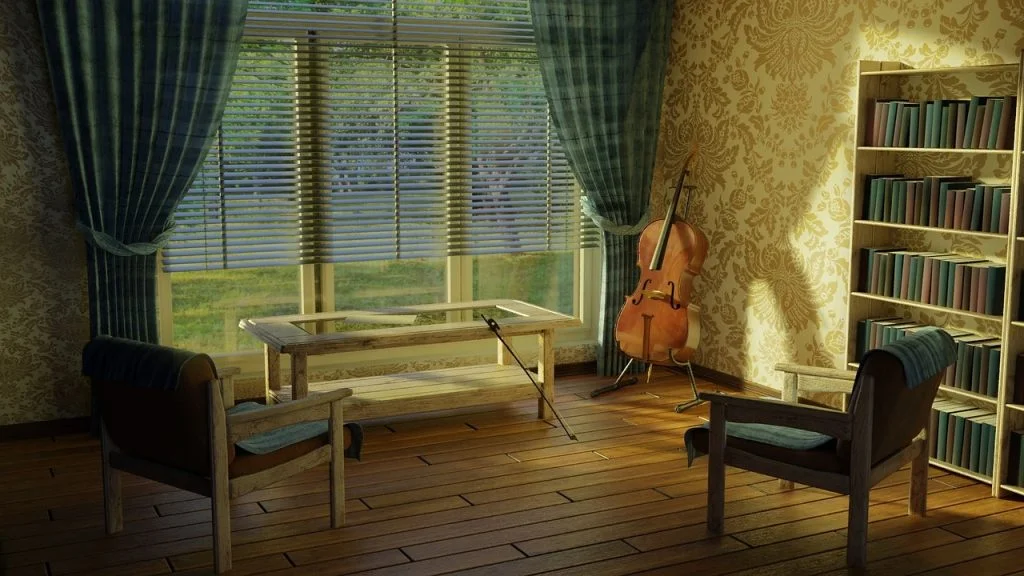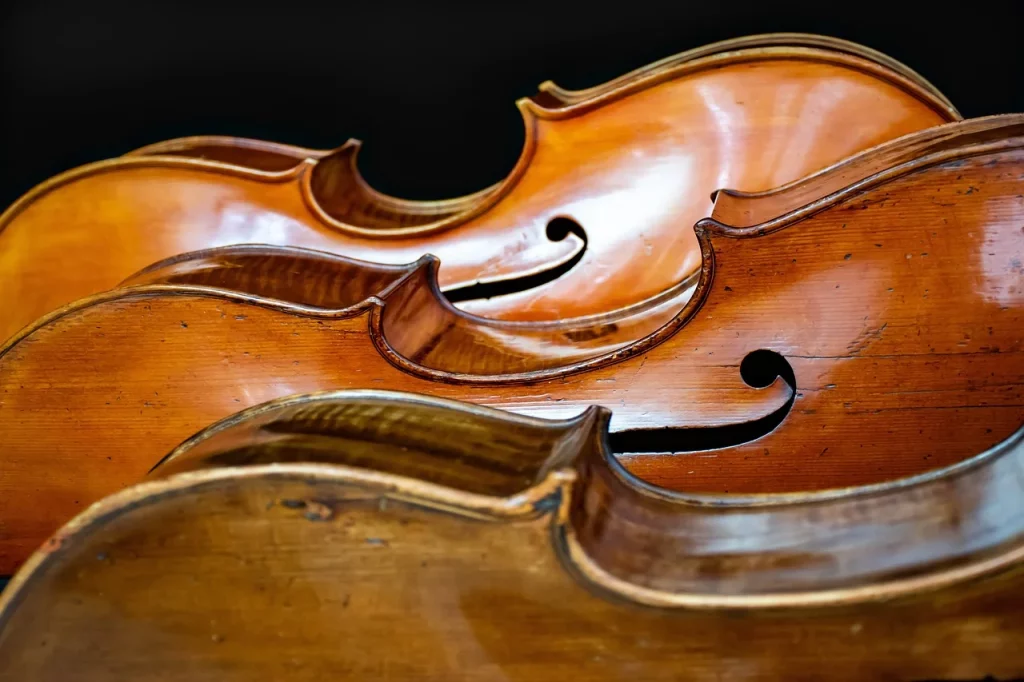Did you know the cello has more stamps in its passport than most of us? Born in Italy during the 16th century, this deep-voiced darling has waltzed into orchestras and living rooms worldwide, charming everyone with its sophisticated vibes.
It’s the kind of instrument that doesn’t just play music; it tells stories, travels through time, and occasionally orders a cappuccino in an Italian café. Have you ever tried ordering a coffee with a violin bow?
The cello is like a beautiful woman who has not grown older but younger with time, more slender, more supple, more graceful.
Pablo Casals
Cello Facts
Dive into the world of cellos with me! Discover fascinating facts about this elegant instrument, and remember, there’s a quiz at the end to test your music knowledge. So, keep your eyes peeled for every detail!
- Cello is short for violoncello, an Italian term.
- The cello first appeared in the early 16th century.
- It is part of the violin family, which includes the violin, viola, and double bass.
- The cello’s range is close to the human voice, which makes it extremely expressive.
- Its full name, violoncello, means ‘little large viol’ in Italian.
- Early cellos had gut strings instead of the modern steel or synthetic ones.
- Antonio Stradivari, a famous luthier, made some of the most valued cellos.
- A cello is typically made from maple and spruce wood.
- Cellos in baroque settings often have tailpiece gut strings and no endpin.
- The endpin was not standard until the 19th century to support the cello’s weight.
- The bow for a cello is shorter and heavier compared to a violin bow.
- Cellos often play the harmony and bass lines in orchestral music.
- They can be solo instruments, as in concertos and solo compositions.

- The fingerboard of a cello is longer to accommodate its range.
- Pablo Casals is considered one of the greatest cellists of the 20th century.
- The cello has four strings tuned in perfect fifths: C, G, D, and A.
- Electric cellos exist, offering a range of electronic effects.
- The sound post inside the cello is crucial for sound projection.
- Cellos are often featured in film scores for their emotional depth.
- Johann Sebastian Bach’s Cello Suites are among the most famous solo cello works.
- The cello’s body shape has evolved for better acoustic performance.
- Cello playing requires precise coordination between left-hand fingerings and right-hand bowing.
- Many cellists use a rosin-coated bow for better grip on the strings.
- The cello is known for its ability to mimic human vocal expressions.
- Yo-Yo Ma, a renowned cellist, has popularized the cello globally.
- The cello’s size requires a special case for transportation.
- Some orchestras tune their cellos to A=442 Hz, slightly higher than the standard A=440 Hz.
- Extended techniques like pizzicato (plucking) and sul ponticello (near the bridge) add to the cello’s versatility.

- The bridge of the cello transfers vibrations from the strings to the body.
- Cellos have inspired modern works in jazz, pop, and rock music.
- The cello’s design has remained largely unchanged since the 18th century.
- Mstislav Rostropovich was a prominent cellist and conductor of the 20th century.
- Cello ensembles, where multiple cellos play together, are becoming popular.
- The spike, or endpin, was added to support the cello’s weight and height.
- Orchestral cellists often play in unison or in octaves with other string instruments.
- Some cellos are made from carbon fiber or other alternative materials.
- The cello can reach higher notes using harmonics, light touches on the string.
- Learning to play the cello usually starts with understanding positions and shifting.

- Electric cellos can be connected to amplifiers and effects units.
- The cello’s sound can vary greatly depending on the maker and materials used.
- Cellos in early music ensembles often use gut strings for authenticity.
- Luis and Clark is a notable maker of carbon fiber cellos.
- The cello’s sound post and bridge are essential for its rich tone.
- Cello bows are traditionally made from pernambuco wood and horsehair.
- Cellos are central to many chamber music ensembles.
- The scroll at the top of the cello is often intricately carved.
- Cello construction is considered a high form of woodworking and craftsmanship.
- Some contemporary composers have explored extended techniques for the cello.
- Cellists often develop a deep emotional connection with their instrument.
- The cello is sometimes used in folk music around the world, showcasing its versatility beyond classical genres.
Cello Myths

With all these facts about the cello fresh in our minds, it’s a perfect time to check some common myths about this instrument and uncover the actual truth.
- Cellos Are Only for Classical Music
While the cello is a staple in classical music, it’s incredibly versatile and used in various genres, including jazz, rock, and even pop. Cellists often experiment with different styles, proving the cello’s adaptability. - You Need to Start Young to Master the Cello
It’s never too late to learn the cello! While starting young can be beneficial, adults are fully capable of learning and excelling at this instrument. Dedication and practice matter more than the age at which you start. - All Cellos Sound the Same
Just like human voices, each cello has its own unique sound. Factors like wood type, construction, and age can significantly affect the instrument’s tone, making each one distinct. - Smaller Cellos Are Just for Children
Smaller cellos aren’t just for kids; they’re also for players who find standard full-size cellos uncomfortable. Comfort and ease of playing are crucial, regardless of the player’s age. - The Cello Is Always a Background Instrument
The cello often shines as a solo instrument, capable of captivating melodies and rich expressions. It’s not just relegated to the background; it can be the star of the show!
No products found.
Cello Quotes

Below you will find some of my favorite quotes about cellos. Feel free to write in the comments your favorite one so I can add it to the list.
I see the cello as a character that can play many different roles.
Yo-Yo Ma
Yo-Yo Ma, a celebrated cellist, views the cello as a versatile instrument capable of adopting various characters and emotions in music.
One must approach the cello as if it were a human voice.
Jacqueline du Pré
Jacqueline du Pré, a legendary cellist, suggests that the cello should be played with the expressiveness and nuance of a human voice.
The cello is a hero, a man of thought, and an aristocrat.
Mstislav Rostropovich
Rostropovich, a master cellist, describes the cello as embodying noble qualities, like heroism, intellect, and aristocracy.
Playing the cello is like participating in a deep conversation without words.
Julian Lloyd Webber
Julian Lloyd Webber, an acclaimed cellist, likens playing the cello to engaging in a profound, non-verbal dialogue.
The cello is the most perfect instrument aside from the human voice.
Steven Isserlis
Steven Isserlis, a prominent cellist, places the cello second only to the human voice in terms of its perfection and expressive capability.
Cello FAQ

I hope these quotes put your mind in harmony. Let’s now check out some of the most common questions asked online. Remember, the quiz is just ahead, so stay focused and don’t disappoint me.
- When was the cello invented?
The cello, short for violoncello, emerged in the early 16th century in Italy. Its exact invention date is a bit hazy, but it’s generally believed to have been developed during the 1530s. The cello evolved from earlier string instruments, like the viola da gamba, and became a prominent member of the string family in orchestras. - Are the cello and bass the same?
No, the cello and the double bass are different instruments. While they both belong to the string family and are played with a bow, there are notable differences. The cello is smaller and is played while seated with the instrument between the knees. The double bass is larger, has a deeper sound, and is usually played standing up or seated on a high stool. Their roles in music also differ, with the cello often playing harmonic and melodic lines and the bass providing the foundational bass line. - What is the typical range of a cello?
The cello has a wide range, extending over four octaves. It’s tuned in perfect fifths, with strings typically tuned to C2, G2, D3, and A3. This allows it to produce deep, rich lows as well as bright, clear highs, making it incredibly versatile in terms of musical expression. - How is the cello different from the violin and viola?
The cello is larger than both the violin and viola and produces a deeper, richer sound due to its size and lower tuning. While the violin and viola are held under the chin, the cello is played sitting down with the instrument resting between the player’s knees. The playing techniques and roles in an orchestra or ensemble also differ among these instruments. - Can the cello be played as a solo instrument?
Absolutely! The cello is a highly expressive instrument capable of a wide range of tones and dynamics, making it excellent for solo performances. It has a rich repertoire of solo pieces, including Bach’s Cello Suites, which are some of the most famous works in classical music. Cellists often perform as soloists in concertos with orchestras and in chamber music settings.
No products found.
Cello Trivia

Get ready to bow your way through the cello quiz! Miss a question, and you’ll find your shoelaces mysteriously tied together by cello strings. Good luck!
Conclusion
As we conclude our exploration of the cello, we find ourselves thrilled by its fascinating facts and its undeniable soul-stirring power. The cello isn’t just strings and wood; it’s a living, breathing entity that speaks a universal language of emotion.
Its versatility across genres, from classical to contemporary, only adds to its allure. What is your favorite cello piece, and how does it make you feel? Sharing your favorites can be a beautiful way to discover new dimensions of this magnificent instrument. Let me know in the comments.
11 Sources Used For This ArticleA Comprehensive Guide to the Cello Instrument – Classical Compass
The Classical Cello Description Page – Classic Cat
Cello – CDN Preter Human
The Cello – Electricka
Cello instrument information – Animato
The Cello vs. the Double Bass – All Shore Orchestra
Difference between a Cello and a Double Bass – Difference Guru
Cello vs Bass Guide – String Budget
Cell vs Double Bass – What’s The Difference – Gear 4 Music
Is the Double Bass the Same as a Cello? – DadanGoray


